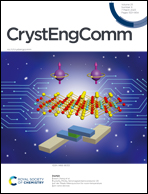Effects of excess Te on the optical and electrical properties of Cd1−xMgxTe single crystals grown by the modified vertical Bridgman method
Abstract
A Cd1−xMgxTe crystal is considered an ideal room temperature radiation detector material due to its excellent opto-electrical properties. In this paper, three large Cd0.95Mg0.05Te ingots with a diameter of 30 mm and a length of more than 100 mm were successfully grown by the modified vertical Bridgman method under different excess Te conditions (0.5 at%, 1.0 at% and 1.5 at%). The results showed that the as-grown Cd1−xMgxTe crystals have cubic zinc-blende structures. The band gap of the crystals ranged from 1.43 eV to 1.52 eV, the density of Te inclusions ranged from 2.7 × 103 cm−2 to 1.0 × 105 cm−2, the resistivity ranged from 8.22 × 106 Ω cm to 1.51 × 1010 Ω cm, and the IR transmittance ranged from 33% to 60%. With the increase of excess Te, the band gap, crystal resistivity and infrared (IR) transmittance decreased, and the density of Te inclusions increased. The analysis of the low temperature photoluminescence (PL) and Raman scattering spectra indicated that the crystal quality deteriorated gradually with the increase of excess Te. The crystal grown under 0.5 at% excess Te conditions had the best optical and electrical properties.



 Please wait while we load your content...
Please wait while we load your content...